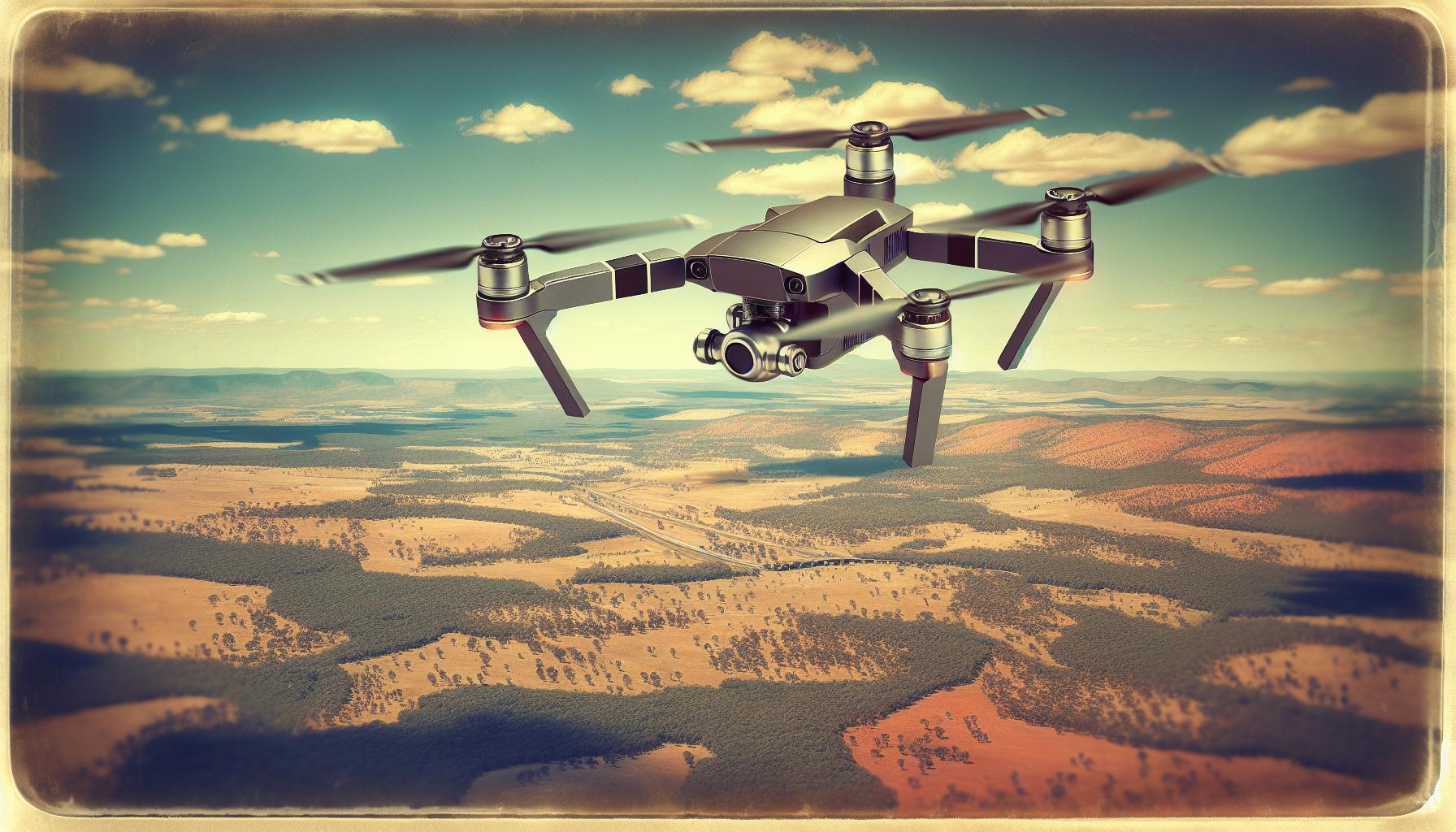Drones have revolutionised the way we capture images and gather data, but how far can they actually fly? Understanding a drone’s range is crucial for hobbyists and professionals alike, influencing everything from aerial photography to delivery services. For those looking to optimise their drone operation skills and adhere to regulations, iDroneTrain Drone Training offers comprehensive courses tailored to Australian standards. This article explores the factors affecting drone flight distance, the latest advancements in technology, and what it means for users looking to maximise their aerial adventures.
Key Takeaways
- Diverse Flight Ranges: Drone flight ranges vary widely, with consumer drones typically achieving 1 to 5 kilometres, while commercial drones can reach 5 to 10 kilometres and long-range models may exceed 20 kilometres.
- Battery Life Importance: The capacity and lifespan of a drone’s battery are crucial, as higher mAh ratings allow for longer flight times, directly affecting how far the drone can travel.
- Impact of Weather: Environmental conditions, such as wind and precipitation, significantly impact drone performance and effective flight distance, making clear weather ideal for operation.
- Regulatory Compliance: Local regulations and no-fly zones can restrict drone flight distances. Operators must be familiar with legal requirements to ensure safe operations and avoid penalties.
- Design and Specifications Matter: The design of a drone, including antenna quality and weight, influences its operational reach and battery efficiency, highlighting the importance of selecting a model suited to user needs.
- Type-Specific Characteristics: Different types of drones are designed for specific uses, with racing drones prioritising speed over distance, while commercial models are designed for extended operational ranges and tasks.
Overview Of Drone Flight Ranges
Drone flight ranges vary significantly based on multiple factors. Specific design features, battery capacity, and regulatory limitations primarily influence these distances.
Common Drone Flight Ranges
- Consumer Drones: Most consumer drones offer flight ranges between 1 to 5 kilometres. These models, intended for recreational use, include features like GPS and Bluetooth connectivity to maintain control.
- Commercial Drones: Commercial drones commonly achieve distances of 5 to 10 kilometres. Designed for tasks like aerial photography and agricultural monitoring, these drones often utilise advanced technologies for better performance.
- Racing Drones: Racing drones typically operate within 500 metres to 2 kilometres. Speed is emphasised over distance; these drones require close-range control for optimal performance.
- Long-range Drones: Long-range drones can exceed flight distances of 20 kilometres. Equipped with powerful batteries and enhanced communication systems, these drones are suitable for extensive surveying or mapping projects.
- Battery Life: The capacity of a drone’s battery directly correlates with its flight range. Drones with higher mAh ratings can fly longer distances without needing a recharge.
- Weight: Heavier drones use more energy. Reducing weight through design optimisation can enhance flight distance.
- Weather Conditions: Wind speed and precipitation impact drone performance. Unfavourable conditions can decrease effective flight range.
- Obstacles: Dense vegetation and buildings create communication barriers between the drone and its controller. Clearer flying areas facilitate longer distances.
- Regulations: Local regulations may limit maximum flight distance. Compliance with these laws is crucial for safe operation.
Understanding the ranges associated with different types of drones helps users choose models that meet their specific needs and operational requirements.
Factors Affecting Drone Flight Distance

Numerous elements influence a drone’s flight distance, impacting both recreational and commercial use.
Battery Life Considerations
Battery life plays a crucial role in determining how far a drone can travel. Standard consumer drones usually offer 20 to 30 minutes of flight time, while advanced commercial models may provide up to 60 minutes. The battery’s capacity directly correlates with the drone’s weight; heavier drones require more power, thereby reducing flight duration. Regular maintenance of batteries, including avoiding extreme temperatures and ensuring proper charging practices, maximises their lifespan and effectiveness.
Environmental Influences
Environmental conditions significantly affect drone performance and distance capabilities. Wind speed and direction can hinder a drone’s ability to maintain a stable course, especially in high winds exceeding 15 km/h. Rain, snow, and extreme temperatures can further impact functionality, leading to decreased flight distance and potential equipment failure. Operating in clear, calm weather ensures optimal range and performance.
Drone Design and Specifications
The design and specifications of a drone determine its operational reach. Drones equipped with high-quality antennas and signal technology typically achieve longer distances. For example, consumer drones may reach 1 to 5 kilometres, while long-range models can extend beyond 20 kilometres. Additionally, aerodynamic design contributes to efficiency, allowing drones to cover more ground with less energy consumption. Understanding specific drone capabilities and features aids in making informed choices aligned with user requirements.
Different Types Of Drones And Their Flight Ranges
Drones vary significantly in flight range, influenced by their design and intended use. Understanding these distinctions helps individuals select the appropriate drone for their requirements.
Consumer Drones
Consumer drones typically have flight ranges of 1 to 5 kilometres. These drones are designed for hobbyists and amateur photographers. Popular models often feature a flight time between 20 and 30 minutes, depending on battery capacity. Environmental factors such as wind and temperature can affect performance, potentially reducing effective distance during use.
Commercial Drones
Commercial drones offer extended flight ranges, generally achieving distances of 5 to 10 kilometres. These models are equipped with advanced technology suitable for tasks like surveying, inspection, and delivery services. Many commercial drones provide a flight duration of up to 60 minutes under optimal conditions, allowing professionals to cover larger areas efficiently. Enhanced communication systems significantly improve their operational range, ensuring reliable connectivity.
Racing Drones
Racing drones are designed for speed and agility, often operating within a distance of 500 metres to 2 kilometres. Their primary focus is on performance rather than extended flight time, resulting in shorter battery lives of around 5 to 10 minutes. However, racers benefit from quick response times and manoeuvrability, enhancing competitive experiences. Modifications to batteries and antennas may further influence their range and performance capabilities.
Regulations Impacting Drone Flights
Regulations significantly influence the distance drones can fly. Understanding these rules is crucial for safe and compliant operations.
Local Laws and Restrictions
Local laws govern drone usage and vary by region. Many countries mandate drone operators to adhere to specific guidelines, which often include obtaining licenses or permits for commercial flights. Some jurisdictions impose altitude limits, typically capping flights below 120 metres (400 feet) to ensure safety in shared airspace. Operators are responsible for familiarising themselves with local laws, including any additional restrictions that may apply to particular areas or occasions. Non-compliance with these regulations may result in fines or the grounding of the drone.
No-Fly Zones
No-fly zones are designated areas where drone flying is prohibited. These zones often include:
- Airports: A minimum distance of 5 kilometres (3.1 miles) from airports is commonly enforced to prevent interference with manned aircraft.
- Military Bases: Flying near military installations is typically restricted due to security concerns.
- National Parks: Many countries restrict drone flights in national parks to protect wildlife and natural resources.
- Event Venues: Restrictions apply during large events, such as concerts or sports matches, to ensure public safety.
Operators must check for no-fly zones before flights, using apps or official resources provided by aviation authorities. Ignoring these restrictions can lead to severe penalties, including drone confiscation and legal action.
Conclusion
Understanding how far a drone can fly is crucial for anyone looking to maximise their aerial capabilities. Flight range varies significantly based on the type of drone and its intended use. Factors like battery life design features and environmental conditions play a vital role in determining distance.
It’s essential for operators to stay informed about local regulations to ensure compliance and safety during their flights. By selecting the right drone and being aware of these factors users can enhance their flying experience while achieving their specific objectives.
Frequently Asked Questions
What is the typical flight range for consumer drones?
Consumer drones generally have a flight range between 1 to 5 kilometres. This range makes them suitable for hobbyists and casual users who want to capture images or videos.
How far can commercial drones fly?
Commercial drones can typically achieve flight distances of 5 to 10 kilometres. These drones are designed for professional tasks, such as surveying and delivery, and are often equipped with advanced features.
What is the flight range of racing drones?
Racing drones operate within a more limited range of approximately 500 metres to 2 kilometres. They prioritise speed and agility, making them ideal for drone racing enthusiasts.
What factors affect a drone’s flight distance?
Several factors influence a drone’s flight distance, including battery life, drone design, and environmental conditions. High-quality antennas and aerodynamics significantly contribute to longer operational ranges.
How long can drones typically fly on a single charge?
Standard consumer drones usually offer flight times of 20 to 30 minutes, while advanced commercial models can last up to 60 minutes. Racing drones have shorter battery lives, typically ranging from 5 to 10 minutes.
Are there regulations that limit drone flight distances?
Yes, regulations heavily influence drone flight distances. Many countries impose altitude limits, often capping flights below 120 metres (400 feet), and have no-fly zones where flying is prohibited.
How can I ensure compliance with drone regulations?
To ensure compliance, operators should research local laws and restrictions before flying their drones. This includes checking for necessary licenses, permits, and specific no-fly zones that may vary by location.



